Master lithographer, sculptor and Graphic artist Kathe Kollwitz dedicated her art to serve the ordinary working people of her time whose hardships tended to be overlooked by the wealthier classes. It was of crucial importance to Kollwitz that her work be moderately priced and widely accessible, features intrinsic to the graphic arts.
In 1898 the painter Max Lieberman founded the Berlin Secession, its membership included artists such as Ernst Barlach, Edvard Munch, Henri Matisse and Kathe Kollwitz. This movement rejected art that served mainly as a diversion for the middle classes, considering that one of art's most important functions was as a means of communication, a universal language for everyday truths, recorded for posterity and with the hope that the impact of this highly emotive media would perhaps shake people awake to begin making changes for the better.
Expression was perhaps one of the most fundamental elements of her work.
"An artist who is also a woman cannot be expected to unravel uncomplicated relationships... as an artist I have the right to extract the emotional content out of everything, to let things work on me and then give them outward form... Expression is all I want." 1
Kollwitz' style was too traditional and naturalistic to place her amongst the order of German 'Expressionist' artists that were her contemporaries. She was an individual, exploring subject matter of great social significance at a time when it was quite unfashionable to do so.
Her life spanned three important eras of German history. She was born in 1867, four years before the creation of Bismarck's 'New German Empire' (1918) under Kaiser Wilhelm. She witnessed the collapse of the Wilhelminian Reich; the birth and eventual demise of the Weimar Republic (1919 -1933), and she was one of the artists outlawed by Hitler's malevolent Third Reich who prohibited the exhibiting of her work, labelling it 'Degenerate Art'.
Kathe Kollwitz died in 1945, just four weeks before Hitler committed suicide.
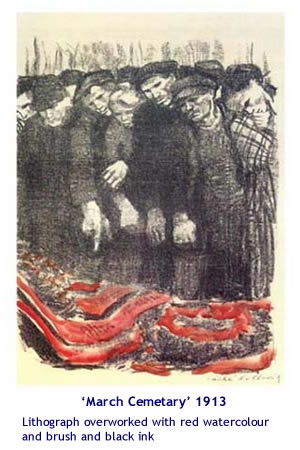
She was born in Konigsberg, Germany on the 8th of July 1867 to parents Karl Schmidt, a master stone mason and architect and Katharina Schmidt, nee Rupp. As a child, she watched the men as they worked on the river Pregel that flowed past the house of her parents on the Weidendamm. She played there among the bricks that had been unloaded from the flatbarges, for her father's building contracting business, alongside her brothers and sister.
"Beautiful to me were the Konigsberg Longshoremen...
... beautiful was the bold outline of the movements of ordinary folk." 2
Her grandfather,
Julius Rupp (1809-1943) had a profound influence upon Kathe. He was the founder
and leader of 'The First Protestant Free Religious Congregation' in Germany,
meeting in defiance of the state controlled church of Kaiser Friederich Wilhelm
IV. She would visit the house of her grandparents on Sunday mornings when
Julius was giving one of his sermons. He spoke to his congregation not only
of the importance of morality, intellect and duty, but also of his concern
about the injustices, perpetrated against the proletariat, reminding them
of the fate of heroes such as those that were massacred in the Berlin uprising
of the 18th of March 1848, the 'Marzgefallenen'.
This subject was later depicted
by Kollwitz in the lithograph, 'March
Cemetary', an image
of the workers paying their respects to those that died in the revolution. The print is finished with red water-colour and brush, and black Ink.
The red a sharp reminder of the blood that was shed and the use of the brush
over the lithograph conjures the texture of the homespun cloth worn by the
workers. The men and women paying homage, are standing together cheek
by jowl in a line symbolising the solidarity that existed between the workers. Their gaunt, grim expressions telling of the immense strain in their lives and sense of resignation but determination to continue the fight for justice.
Kathe Kolwitz' father, a dedicated social democrat, actively encouraged her to pursue a career as an artist, he recognised her talent, from her early drawings of the longshoremen and market workers. He arranged for her to receive her first art lessons in 1881-1882 from the engraver Rudolf Maurer (1805-1945) in Konigsberg, who first introduced her to printmaking. When Kathe was seventeen, Schmidt sent her away to study at the 'Zeichnen - und Malschule des Vereins der Kunstlerinnen' in Berlin, a School for women artists, hoping that there she would avoid the distraction of romance. Marriage, he felt, would detract too much from her time that could otherwise be used for the development of her career as an artist. Later Kathe said of him and her grandfather:
"I feel the influence of two generations in me: My father....because he served to introduce me to socialism, socialism understood as the much desired Brotherhood of Man. Behind him stood Rupp, a being linked not to man but to God, the religious man." 3
She was tutored by the Swiss artist Karl Stouffer-Bern, at this stage she was still intent on becoming a painter. Stauffer-Bern was instrumental in guiding her into the field of the graphic arts by introducing her to the works of Max Klinger, in particular his cycle of etchings entitled 'A Life'.
"In this highly influential work, Kollwitz found validation for the direction she would eventually choose." 4
Later she read Klinger's treatise 'Painting and Drawing' which helped to strengthen her conviction that the graphic arts were the only valid direction for her talents.
In 1886 Kathe returned to Konigsberg where she studied with Emil Neide, this was also the year that she got engaged to Karl Kollwitz, a medical student, much to the consternation of her father.
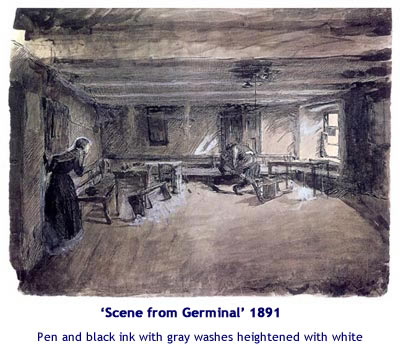
In 1888 she went to Munich, where she studied painting and the use of colour under Ludwig Herterich for two years, but Kathe did not feel comfortable working in this field. In a letter to a friend, Paul Hey, she remarked:
"With my eyes, I always paint very well but with my hands I'm deficient." 5
Kathe returned once again to Konigsberg in 1890 where she rented a studio and began experimenting with graphic art. Her first cycle of etchings were based on 'Germinal', Emil Zola's naturalist mining novel.
On the 13th June the following year, she married Dr Karl Kollwitz, they moved to 25 Weissenburger Strasse in Berlin, where Karl established his practice, (Kathe-Kollwitz-Strasse in the Prenzlaver Berg district, as it is known today). Kathe's contact with Karl's working class patients afforded her valuable insight into the kind of lives that these under privileged people had to lead:
"Frau Pankopf was here. She had a completely black eye. Her husband had gone into a fit of rage.... The more I see of this, the more I understand that this is the typical misfortune in workers' families. As soon as the husband drinks or is sick and without work, the same thing happens. Either he hangs like a dead weight on his family ... or he becomes melancholy ... or goes mad ... or commits suicide. For the woman it is always the same misery. She maintains the children, whom she must feed ...." 6
In 1893 after the birth of her first son Hans in 1892, Kathe attended the opening performance of Gerhart Hauptmann's controversial play 'The Weavers'.
She abandoned the series on 'Germinal', and began work on a new cycle entitled 'A Weavers` Rebellion'.
This cycle, completed in 1897, consisted of six images: '
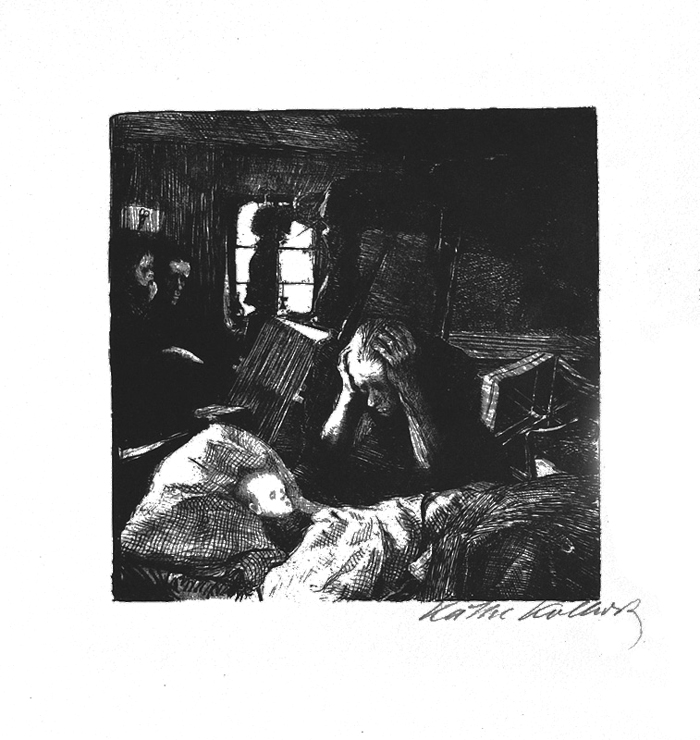
Poverty':
An anguished mother, head in hands, crouches over the bed of her starving
baby, while the gaunt figure of her husband watches over.
The
room is dark and we may gather, from the weaving equipment in the
background, that the family live, sleep and work, in this same room.

'Death'
depicts a woman, a man and a child in a small dark room with a low ceiling.
From the middle of the group a deathly skeleton figure, one arm enfolding the despairing child around the neck, the other reaching towards the exhausted figure slumping against the wall.
Kollwitz' manipulation of the light shining from the candle on the table is a powerful and thematic contrast, it brings the illusion of life to the image on the japan paper.
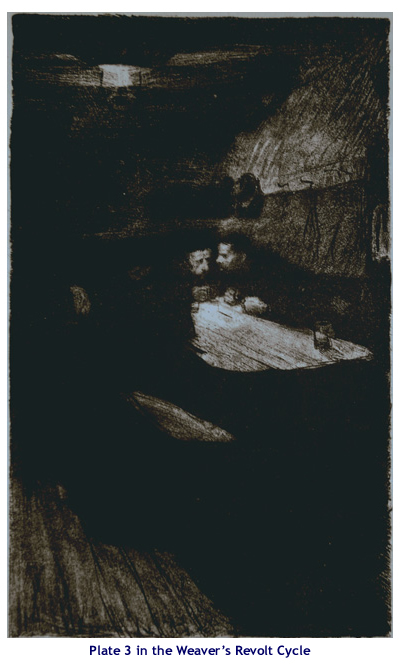
'Council'
Kathe Kollwitz made three versions of this work, the first two as etchings; this final one via lithography, which allowed her to create the illusion of a dark smoky room in which no one can be seen clearly.
The cycle so infuriated Kaiser Wilhelm that he refused to let Kollwitz go to Paris to accept the Prix de Rome.
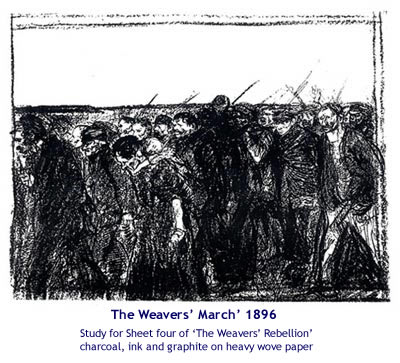 'March of the Weavers'
'March of the Weavers'
Mixed emotion amongst the workers
as they march. Some wear expressions of weary resignation. Others look adamant, determined. Some just look cold and hungry, depressed.
One of them carries and exhausted looking child.
The charcoal conjures the black mood and anger enveloping the weavers, who shout with anger and frustration as they march.
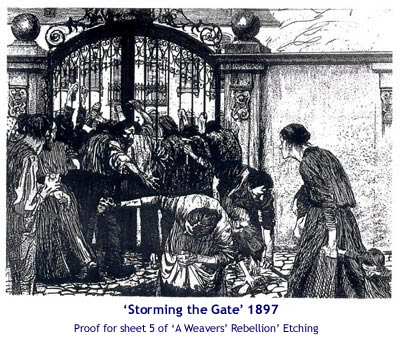
'Storming
the Gate'
Workers
pick up stones for ammunition from the pavements outside the gates of a mansion belonging to the landowner resting in false security behing the immense and ornately wrought, iron gate.
 'End'
the last plate in the cycle, again Kollwitz`masterful manipulation
of light and shade that gives her work such clarity and depth. In this print the dead strikers being laid out in the room of
an old woman, her face is grief stricken but her fists are clenched in anger
as the bodies are carried in.
'End'
the last plate in the cycle, again Kollwitz`masterful manipulation
of light and shade that gives her work such clarity and depth. In this print the dead strikers being laid out in the room of
an old woman, her face is grief stricken but her fists are clenched in anger
as the bodies are carried in.
"Kollwitz adhered to the traditional academic practice in producing the cycle, making preparatory studies of individual elements, assembling them into a finished compositional sketch, and reworking it onto the copper plate, which she built up over a series of states." 7
'A Weavers'
Rebellion' was exhibited at the Greater Berlin Art Exposition and earned
her a nomination for the gold medal, but the decision to award her the medal
was vetoed by the Kaiser, who considered the subject matter to be insurgent.
However in 1899, Kollwitz was awarded the silver medal from the German Art
Exposition in Dresden (the Kaiser did not have as much influence there).
Kollwitz
was very much encouraged by how well'The Weavers Rebellion' was received:
"The choice of this infamous work guaranteed her an audience and established her reputation as an advocate for the downtrodden." 8
She was the first to admit that her choice of rural and urban proletariat as subject matter was not entirely due to her social conscience:
"I would like here to say something about the characterisation as 'social' artist, that accompanied me from then on. Certainly my work by then already referred to socialism through the attitude of my father, my brother and through all the literature of that era. My actual motive, however, for choosing from now on the representation of the life of the worker was that selected motifs form that sphere simply and unconditionally were what I perceived as beautiful.....People from the bourgeoisie were entirely without charm for me. The bourgeois life seemed entirely pedantic to me. On the other hand, the proletariat had great style." 9
 There followed a particularly prolific period for Kollwitz creatively. During this time she
conducted experiments with colour printing, pastels and chalks, creating many
of her self portraits, nudes and the 'Women with Dead Child' series 'Die Carmagnole'
There followed a particularly prolific period for Kollwitz creatively. During this time she
conducted experiments with colour printing, pastels and chalks, creating many
of her self portraits, nudes and the 'Women with Dead Child' series 'Die Carmagnole'
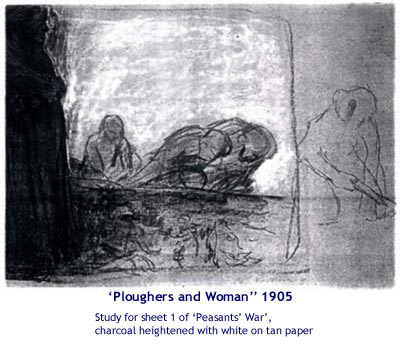
In 1902 Kathe started to work on some experimental sheets for 'Peasants War', a commission that she had received from the Society for Historical Art.
She visited Paris in 1904, for several weeks, where she studied Sculpture at the 'Academie Julian', she met Rodin at his studio and spent time making several drawings and pastels from the life that she observed in the Paris markets and night spots. Upon her return from Paris she continued with her 'Peasants War' series, which she completed in 1908.
"Her most ambitious work technically. It cements her reputation as one of the foremost German printmakers." 10
In 1914 Kollwitz' sons volunteered for army service. Her youngest son Peter was killed on 22 October in Dixmuiden in Belgium. This sad event stoked up her outrage for what she perceived to be such a completely unnecessary waste of human life. She questioned the logic that compelled young men to be so eager to die for their country.
In 1918, after the poet Richard Dehmel made his appeal to all capable Germans "to sacrifice themselves to the Fatherland", the Social-Democratic newspaper 'Vorwark' published her angry reply:
'She answers that enough people have died and that no more should fall. She quotes from a greater poet than he, Goethe, with the words: "Seed corn must not be ground."'
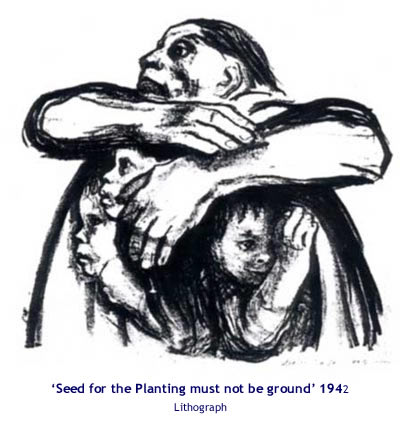
She used this quote as the title for the last lithograph made by her, in 1942, which shows a woman desperately covering her young children with her arms to
prevent them being taken away from her. The expression upon the woman's face
is one of defiance.
Kollwitz would simplify the figures in her pictures so
much that they became almost like charicatures. Perhaps the intention
behind this was to maximise the accessibility of the messages that she was
intending to convey. Her determination that her artwork should be readily
available and affordable to everyone, together with the posters that she made
for so many social causes resulted in her becoming one of the most well known
and well loved graphic artists of her time.
References
- 1. Entry into 'Kathe Kollwitz`' diary of 1922 || <<Back to text >> ||
- 2. P.91, para 3. Kollwitz In Context by Alessandra Comini || <<Back to text >> ||
- 3. P.177, para 3. Kathe Kollwitz || <<Back to text >> ||
- 4. P.15, para 2. Kollwitz Reconsidered || <<Back to text >> ||
- 5. Kollwitz letter to Paul Hey, 22 September 1889, Kollwitz 1966,16 || <<Back to text >> ||
- 6. Kollwitz 1989, 41–3, entry of 19 september 1908 || <<Back to text >> ||
- 7. P.24, para 2. Kollwitz Reconsidered || <<Back to text >> ||
- 8. P.21, para 1. IBID || <<Back to text >> ||
- 9. Kollwitz 1989, p.741. 11 P.180, para 2 Kathe Kollwitz || <<Back to text >> ||
- 10. P.180, para 11, IBID || <<Back to text >> ||
Bibliography
- Kathe Kollwitz, by Elizabeth Prelinger with essays by Alessandra Comini and Hildegard Bachert.
National Gallery of Art, Washington. Yale University Press, New Haven and London. - Kollwitz, Kathe. Briefe der Freundschaft Und Begegnungen, edited by Hans Kollwitz Munich 1966.
- Kollwitz, Kathe. Die Tagebucher, edited by Jutta Bohnke-Kollwitz. Berlin 1989.
- Spaightwood Galleries, Inc
